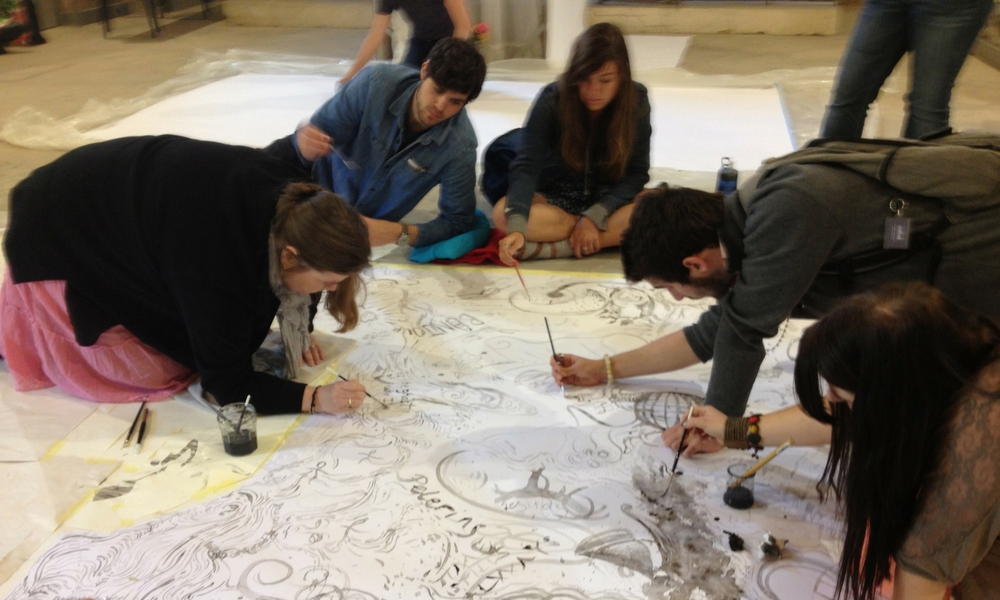Agnes Carbrey "Making the Unconscious Conscious" through Art and Counseling
School of Art Design and Art History
"Deep reflection is required of the artist and over the years, as a professional artist, I have found a unique voice with connection to my authentic self. In counseling, each individual also has to find this deep, honest connection and understanding of themselves in order to live more fully. Positive growth can arise from facing the difficulties and blessings that are present in our “here and now”.
Agnes Carbrey is an established artist, who has shown and sold art all over the world; she could look at herself and feel satisfied in her career. Instead, she asks herself, “What’s next?” After teaching in New York City at Parsons School of Design and studio art at James Madison University for the past 12 years, Carbrey decided that she, too, was not finished learning and enrolled in what she calls “accidental graduate school.” A student in the Clinical Mental Health Counseling program at JMU, Carbrey approaches this new area of academia with a creative eye. In this second calling, Carbrey is finding common ground between arts and counseling. She recently completed a month-long residency at the Virginia Center for Creative Arts producing work that explores the healing, restorative side of art, an example of which is on exhibit at the Taubman Museum of Art in Roanoke through July 16.
VCCA offers lodging and studio space for 25 artists at a time, serving over 500 artists every year between their locations in Sweet Briar, Virginia, and at Moulin A Nef in Auvillar, France. It is a highly selective and competitive residency program, and composers, filmmakers, poets and choreographers join the mix of creative persons.
As she works through her coursework in the Clinical Mental Health Counseling program, Carbrey finds numerous connections between art and counseling. “One of the phrases at play in both art and psychology is ‘making the unconscious conscious.’ And that’s what I often do in art,” she said. “I take something that’s inside me, that is intuitive and universal, and perhaps speaks to all humans, and I put it out into the world in the boldest way.” Carbrey explained that discovering one’s voice may occasionally be difficult, yet necessary and ultimately rewarding and profound.
“While [this art] may not look pretty or be something most people would want to hang over the fireplace, the beauty is in its truth to the individual,” she said. The connection between art and counseling lies in helping people understand themselves more fully.
Art has served as Carbrey’s self-therapy for years. At VCCA, she tapped into difficult periods of her life to create new work that explores the healing process. “I want to show how things can be frightening, but healing, and you can get through them, so ultimately it’s a positive experience.”
She incorporates this artistic process of therapy in her classes at JMU too, challenging her students to tell their own stories through art. “We make giant 4 x 7 foot self-portraits, but not in the traditional sense. The student conveys a time when he or she had a life challenge and came through it with resilience. Most realize they are processing their artistic voices and also finding intuitive healing by the art they make – it becomes meaningful through insight from their own true narratives.”
Familiar with the therapeutic nature of art through her own journey, Carbrey desires to delve even deeper into psychological theory and practice. In describing the range of counseling techniques she has learned in graduate school, she says, “We learn how to do long term psychoanalysis – self object relationship and psychoanalytical theory but also crisis counseling and brief counseling, where we help a client in one to five sessions – for example: working with a client who has anxiety, and helping them learn coping skills to manage their natural human emotions, practicing self-care to become confident again. We learn techniques that can be applied as you need them, or that you can merge together to create your own unique philosophy in counseling. The JMU Counseling Center, in fact, is an outstanding innovator in skills treatment programs for anxiety, social anxiety, eating disorders, emotional regulation, mindfulness and substance use.”
After finishing her practicum, Carbrey will have a year of internship before entering her new role as a clinical mental health counselor. “I’m excited to step into this new role. I’ve got a lot of wisdom at this point in my life and education, and I want to integrate all the tools I’ve learned from the graduate faculty and the JMU Counseling Center,” she explained. “JMU has taught me so much.”
Perhaps the greatest bit of wisdom Carbrey brings to the table is that we should never stop pursuing new goals with curiosity and passion. “I’ve discovered something new about myself.” Carbrey smiles. “Those eight hours a day alone in the studio for 25 years? I don’t like that. I want to be with people. I feel like I’ve accomplished one goal, and now I want to connect more with people each and every day for the rest of my life.”
